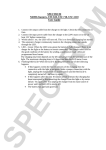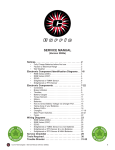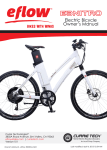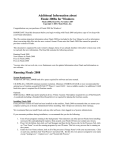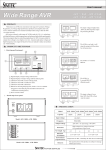Download Currie Tech Service Manual.indd
Transcript
TAKING CARE OF YOUR BATTERIES Proper maintenance of the batteries will maximize their lifespan and available ride time. Currie Technologies® warrants your new batteries from the date of purchase but only if properly cared for. Refer to the limited warranty for details. Currie uses SLA (Sealed Lead Acid), NiMH (Nickel Metal Hydride) or Li-Ion (Lithium Ion) batteries in all of our hybrid electric bicycles. These are all very user friendly types of batteries when cared for properly. • Batteries should be fully charged immediately when they are received for the recommended charge times. FULLY CHARGE BATTERIES BEFORE FIRST USE. Below are the recommended charge times for each type of batteries. • Li-Ion (Lithium Ion) batteries 4-6 hours • NiMH (Nickel Metal Hydride) 4-6 hours • SLA (Sealed Lead Acid) batteries 6-8 hours • Charge batteries at least every 90 days for NiMH & Li-Ion and every 30 days for SLA until normal use is resumed. • Always store bicycle with fully charged batteries. • Never charge the batteries for more than 24 hours. • Always disconnect the charger from the wall outlet and bicycle when charging is complete (as indicated by the status on the charger) before storing the bicycle. • DO NOT STORE BATTERIES BELOW 50º FAHRENHEIT AND NEVER ALLOW BATTERIES TO FREEZE (BELOW 32º FAHRENHEIT). • Bikes are equipped with a 5 minute sleep mode. If no activity is detected after 5 minutes the bike will go into stasis mode to conserve the batteries. To restart, cycle the power switch “OFF” then “ON”. Bikes are not to be stored in the 5 minute sleep mode. Be sure to turn the power switch "OFF" when the bike in not in use. • ALWAYS BE SURE TO TURN THE BIKE “OFF” AFTER EACH USE VIA THE ON/OFF POWER SWITCH. If you have left the power switch on or your product has not been charged for a long period of time, the batteries may reach a stage at which it will no longer hold a charge. • Be friendly to the environment! Be sure to recycle your old batteries at a local battery recycling center. Do not throw them in the garbage! • Frequent “stops and starts” will drain a battery more quickly than continuous riding • Even with proper care, rechargeable batteries does not last forever. Average battery life depends on use and conditions. Disposal requirements for batteries The batteries supplied in your iZip™ hybrid electric bicycle are unsuitable for regular trash disposal receptacles. Take the battery to an approved battery recycler. Concerns regarding battery safety All iZip™ hybrid electric bicycles batteries. In the unlikely event that you suspect fluid is leaking from your battery please follow precautions below. Internal exposure: Contact a physician immediately. External exposure: Contact a physician immediately. Flush immediately for 15 minutes if acid gets in eyes or on skin. ! Battery acid can cause blindness or severe burns. Contact physician immediately if you have been exposed to battery acid. Currie Technologies // Service Manual (Version 2008a) 15 BATTERY FAQ'S Q: Do I need to charge the batteries before using them? A: Yes, you should charge the batteries fully before first using them. Q: What is conditioning (NiMH only)? A: The conditioning process is performed by first draining the batteries and then charging them fully. Conditioning is recommended for every ten to twenty charges. Q: Do I need to "break-in" my batteries? A: Yes, the batteries used in the Currie Hybrid Electric Bicycles will need to have a “break-in” cycle consisting of ~ three discharge/ charge cycles before they will reach optimum performance. This involves three complete discharges and three complete recharges. After this initial “break-in” cycle the batteries will have maximum possible performance and less line voltage fluctuations under load. Q: How long will the batteries hold their charge? A: All batteries will self-discharge when not in use. The self-discharging rate depends on the temperature at which they are stored. Excessively cold or hot storage temperatures will drain the batteries faster than normal. Ideally the batteries should be stored at room temperature. Q: Why should I recharge my batteries at least every 90 days (NiMH & Li-Ion) and every 30 days (SLA) when I am not using them? A: Batteries naturally loose their charge over time. To keep the batteries in optimal condition and extend their life, it is recommended that a top-off recharge be performed at least every 90 days for NiMH & Li-Ion batteries and at least every 30 days for SLA batteries. Not maintaining the batteries will cause them to lose performance and have a shorten lifespan. Q: What happens if I leave the power switch on longer than 5 minutes? A: Currie bikes are equipped with a 5 minute shut-off mode. If no activity is detected after 5 minutes the bike will turn itself off to protect the batteries. To restart, cycle the power switch (OFF then ON). If you have left the power switch on or your product has not been charged for a long period of time, the batteries may reach a stage at which it will no longer hold a charge. Q: Will I get more performance from my bike if I leave the batteries to charge longer? A: No, once the batteries are fully charged (as indicated by the light on the charger) it is best to unplug them from the charger. Leaving the batteries charging longer than necessary is called “overcharging” and will not increase performance. Currie-supplied chargers are designed to avoid over-charging a battery. Still we recommend that you always unplug a charger after the unit is fully charged to avoid the possibility of unanticipated circumstances such as an unexpected power surge from a lightning strike (or other power line anomaly) potentially causing damage. Only use Currie-supplied chargers. Q: Is it normal that the batteries get warm when recharging? A: Yes, it is normal that the batteries will become warm to the touch during the recharging process. This is because the increase of internal resistance and less energy conversion efficiency from electric energy to chemical energy. Q: How long will my batteries last before needing replacement? A: Average battery life depends on use and conditions. Even with proper care, rechargeable batteries does not last forever. Q: How will I know when to replace my batteries? A: Some or all of the following may occur possibly indicating that the batteries have reached their useful lifespan and will need to be replaced. Shorter ride time than normal • Less power while riding than when your hybrid electric bicycle was new • Reduced time to full charge as indicated by indicator light on charger. For example a fully depleted SLA battery should take • 8-10 hours to fully charge, if the charger shows a full charge after only 2 hours than the batteries may need to be replaced.) Inability to get a full charge from the charger. Charger never stops blinking or stays red even after charging for the full time • Q: What is battery sulfation and how do I prevent it? A: During normal operation of lead-acid batteries, lead sulfate forms on the battery plates. This process is called sulfation. During this process the sulfates expand and crystallize, choking the plates and thus reducing battery efficiency to the point where the battery will not accept a charge. Sulfation build-up on battery plates is a common cause of battery failure. The easiest way to prolong the onset of sulfation is to keep the batteries fully charged. Q: What should I do with my old batteries? A: Contact your local battery recycling center in order to properly dispose of the batteries. Never dispose of batteries in the garbage. Currie Technologies // Service Manual (Version 2008a) 16 CHARGER The hybrid electric bicycle comes with its own "Smart Charger” that connects with an easy-access charger port for recharging the batteries. This charger unit has lights that show the battery charge status. Refer to the instructions that appear on the charger unit and its instructions. Batteries work best when they have a full charge, so always be sure to recharge them fully after each ride. If you leave them in a run-down condition, without recharging them, it will shorten their life expectancy. • • • Li-Ion (Lithium Ion) batteries - charge for 4-6 hours for full charge NiMH (Nickel Metal Hydride) batteries - charge for 4-6 hours for full charge SLA (Sealed Lead Acid) batteries - charge for 6-8 hours for full charge The charger may get warm to the touch, so make sure you charge them in an open area and do not lay anything on the charger unit while charging. Although you cannot over-charge the batteries using the Currie “Smart Charger”, we recommend that you do not leave the charger plugged in for more than 24 hours. If your charger shows a solid green light after charging for a short period of time, your battery may have been only partially discharged (short ride), or this may be the sign of a partially worn out battery with reduced storage capacity. Continue charging for the full time, to cover all the bases. If the battery still has not charged, you may need to replace it. Even with proper care, a rechargeable battery does not last forever. Average battery life depends on use and conditions. ! The charger and charger port should be regularly inspected for damage (cord, plug, enclosure, etc.). If damage is found stop using until the damaged part can be repaired or replaced. Currie Technologies // Service Manual (Version 2008a) 17 HOW TO USE THE NIMH AND LI-ION CHARGERS Before using the charger locate the voltage selector switch (NiMH and Li-Ion chargers only) on the back of the charger. Select either 115 Volts or 230V Volts depending on the country you reside in. Using the 115V setting in a 230V country will permanently damage the batteries and/or set off the fuse. Using the 230V setting in a 115V country will put no useful charge on the batteries. Back Side of Charger Example of NiMH Charger 115 1. Plug the charger into the outlet and turn the charger “ON” via the switch on the back side. The red power light on the front of the charger will illuminate when the charger is working properly. 2. Insert the XLR plug (round plug with 3 pins) into the charger port on the bike being sure the charger plug is fully seated in the charger port. The second light will start to flash orange for several seconds while the charger is “seeking” the battery. 3. Once the charger has "found" the battery the blinking orange light will stop flashing and turn solid orange and the cooling fan will start. At this point the charge process has begun. 4. Once the battery reaches full charge, the orange light will turn solid green. 5. When charging is complete, unplug the charger from the wall before removing it from the charger port. Example of Li-Ion Charger Charge for the full time. If the battery still has not charged, you may need to replace it. Orange/Green light Electric Bikes with internal battery packs - Rotate the charger port cover and attach charger. FUSE Front Side of Charger ! Use only Currie Authorized Li-Ion chargers with bicycles equipped with Li-Ion batteries. Using any other charger will damage the batteries and void your warranty. ! Use only Currie Authorized NiMH chargers with bicycles equipped with NiMH batteries. Using any other charger will damage the batteries and void your warranty. Currie Technologies // Service Manual (Version 2008a) 18 HOW TO USE THE SLA CHARGERS (STANDARD) 1. Plug the charger into the outlet. The indicator light on the top of the charger will illuminate when the charger is working properly. Refer to the sticker on the charger for actual status light indication. 2. Insert the plug (XLR, 2v1h or 3v) into the charger port on the bike being sure the charger plug is fully seated in the charger port. The light should be solid red or blinking green to indicate charging however you will need to refer to the sticker on the charger for actual status light indication. 3. Once the battery reaches full charge, the light will return to solid green however you will need to refer to the sticker on the charger for actual status light indication. 4. When charging is complete, unplug the charger from the wall before removing it from the charger port. Charge for the full time. If the battery still has not charged, you may need to replace it. Example of SLA Charger w/ XLR Plug SLA Charger could come with the below plugs depending on your model of hybrid electric bicycle XLR Plug Electric Bikes with Seat Tube Mounted Battery (STB) Packs - Remove the power cable from the charger port and attach charger. 2v1h Plug 3v Plug Electric Bikes with Rack Mounted Battery (RMB) Packs Lift the battery pack handle to expose the charger port and attach charger. ! Use only Currie Authorized SLA chargers with bicycles equipped with SLA batteries. Using any other charger will damage the batteries and void your warranty. Currie Technologies // Service Manual (Version 2008a) 19





